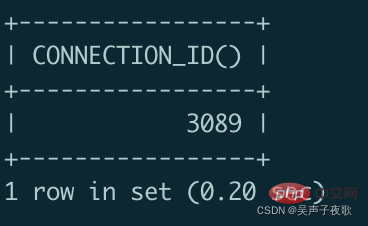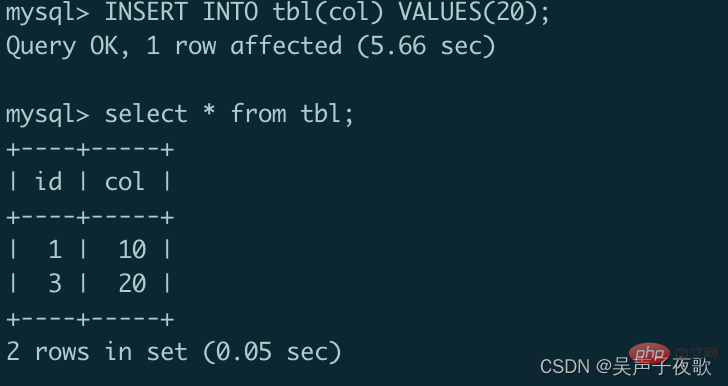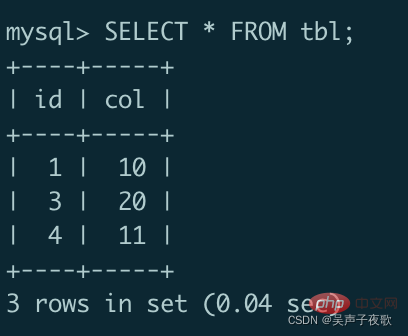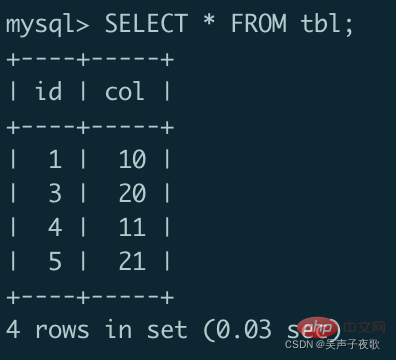MySQL syntax analysis table locking
This article brings you relevant knowledge about mysql, which mainly introduces the relevant syntax analysis about table locking. MySQL allows client sessions to explicitly acquire table locks to prevent other sessions To access the same table within a specific time period, let’s take a look at it. I hope it will be helpful to everyone.

Recommended learning: mysql video tutorial
MySQL table lock
A lock is a sign associated with a table. MySQL allows client sessions to explicitly acquire table locks to prevent other sessions from accessing the same table for a specific period of time. A client session can acquire or release table locks only for itself. It cannot acquire or release table locks for other sessions.
CREATE TABLE tbl ( id INT NOT NULL AUTO_INCREMENT, col INT NOT NULL, PRIMARY KEY (id)) Engine = InnoDB;
LOCK and UNLOCK TABLES syntax
The following statements explicitly acquire table locks:
LOCK TABLES table_name [READ | WRITE]
To lock a table, specify its name after the LOCK TABLES keyword. Additionally, you can specify the type of lock, which can be READ or WRITE.
To release the table lock, please use the following statement:
UNLOCK TABLES;
Read lock
READ lock has the following characteristics:
- READ can be passed Multiple sessions acquire table locks at the same time. Additionally, other sessions can read data from the table without acquiring a lock.
- A session holding a READ lock can only read data in the table, but cannot write. Additionally, other sessions cannot write data to the table until READ releases the lock. Write operations from another session will enter a wait state until the READ lock is released.
- If the session terminates normally or abnormally, MySQL will implicitly release all locks. This feature is also related to WRITE lock.
Example:
In the first session, first, connect to the mysqldemo database and use the CONNECTION_ID() function to get the current connection ID, as shown below:
SELECT CONNECTION_ID();

Then, insert a new row in the tbl table.
INSERT INTO tbl(col) VALUES(10);
Next, query the data in the tbl table.
SELECT * FROM tbl;

Afterwards, to obtain the lock, use the LOCK TABLE statement.
LOCK TABLE tbl READ;
Finally, within the same session, if you try to insert a new row in the tbl table, you will get an error message.
INSERT INTO tbl(col) VALUES(11);

So once READ acquires the lock, it cannot write data to the table in the same session.
Check the lock from another session.
First, connect to mysqldemo and check the connection ID:
SELECT CONNECTION_ID();

Then, retrieve the data from the tbl table:
SELECT * FROM tbl;

Next , insert a new row in the tbl table:
INSERT INTO tbl(col) VALUES(20);

The insert operation from the second session is waiting because the first session READ has acquired the lock on the tbl table, But it has not been released yet.
You can view detailed information from SHOW PROCESSLIST.
SHOW PROCESSLIST;

After that, return to the first session and use the UNLOCK TABLES statement to release the lock. After READ releases the lock from the first session, INSERT performs the operation in the second session.
unlock tables;
Finally, check the data of the tbl table to see if the INSERT operation of the second session is actually executed.
SELECT * FROM tbl;

Write lock
WRITE lock has the following characteristics:
- The only session holding the table lock can read from the table Fetch and write data.
- Other sessions cannot read data from and write data to the table until the WRITE lock is released.
First, WRITE acquires the lock from the first session.
LOCK TABLE tbl WRITE;
Then, inserting a new row in the tbl table
INSERT INTO tbl(col) VALUES(11);
is useful.
Next, read data from the tbl table.
SELECT * FROM tbl;

It works too.
Afterwards, starting from the second session, try to write and read data:
INSERT INTO tbl(col) VALUES(21); SELECT * FROM tbl;


最后,从第一个会话中释放锁定。
UNLOCK TABLES;
看到第二个会话中的所有待处理操作都已执行,下图说明了结果:
读锁与写锁
- 读锁是“共享”锁,它可以防止正在获取写锁,但不能锁定其他读锁。
- 写锁是“独占”锁,可以防止任何其他类型的锁。
推荐学习:mysql视频教程
The above is the detailed content of MySQL syntax analysis table locking. For more information, please follow other related articles on the PHP Chinese website!

Hot AI Tools

Undresser.AI Undress
AI-powered app for creating realistic nude photos

AI Clothes Remover
Online AI tool for removing clothes from photos.

Undress AI Tool
Undress images for free

Clothoff.io
AI clothes remover

AI Hentai Generator
Generate AI Hentai for free.

Hot Article

Hot Tools

Notepad++7.3.1
Easy-to-use and free code editor

SublimeText3 Chinese version
Chinese version, very easy to use

Zend Studio 13.0.1
Powerful PHP integrated development environment

Dreamweaver CS6
Visual web development tools

SublimeText3 Mac version
God-level code editing software (SublimeText3)

Hot Topics
 1382
1382
 52
52
 MySQL: Simple Concepts for Easy Learning
Apr 10, 2025 am 09:29 AM
MySQL: Simple Concepts for Easy Learning
Apr 10, 2025 am 09:29 AM
MySQL is an open source relational database management system. 1) Create database and tables: Use the CREATEDATABASE and CREATETABLE commands. 2) Basic operations: INSERT, UPDATE, DELETE and SELECT. 3) Advanced operations: JOIN, subquery and transaction processing. 4) Debugging skills: Check syntax, data type and permissions. 5) Optimization suggestions: Use indexes, avoid SELECT* and use transactions.
 How to open phpmyadmin
Apr 10, 2025 pm 10:51 PM
How to open phpmyadmin
Apr 10, 2025 pm 10:51 PM
You can open phpMyAdmin through the following steps: 1. Log in to the website control panel; 2. Find and click the phpMyAdmin icon; 3. Enter MySQL credentials; 4. Click "Login".
 MySQL: An Introduction to the World's Most Popular Database
Apr 12, 2025 am 12:18 AM
MySQL: An Introduction to the World's Most Popular Database
Apr 12, 2025 am 12:18 AM
MySQL is an open source relational database management system, mainly used to store and retrieve data quickly and reliably. Its working principle includes client requests, query resolution, execution of queries and return results. Examples of usage include creating tables, inserting and querying data, and advanced features such as JOIN operations. Common errors involve SQL syntax, data types, and permissions, and optimization suggestions include the use of indexes, optimized queries, and partitioning of tables.
 Why Use MySQL? Benefits and Advantages
Apr 12, 2025 am 12:17 AM
Why Use MySQL? Benefits and Advantages
Apr 12, 2025 am 12:17 AM
MySQL is chosen for its performance, reliability, ease of use, and community support. 1.MySQL provides efficient data storage and retrieval functions, supporting multiple data types and advanced query operations. 2. Adopt client-server architecture and multiple storage engines to support transaction and query optimization. 3. Easy to use, supports a variety of operating systems and programming languages. 4. Have strong community support and provide rich resources and solutions.
 How to use single threaded redis
Apr 10, 2025 pm 07:12 PM
How to use single threaded redis
Apr 10, 2025 pm 07:12 PM
Redis uses a single threaded architecture to provide high performance, simplicity, and consistency. It utilizes I/O multiplexing, event loops, non-blocking I/O, and shared memory to improve concurrency, but with limitations of concurrency limitations, single point of failure, and unsuitable for write-intensive workloads.
 MySQL's Place: Databases and Programming
Apr 13, 2025 am 12:18 AM
MySQL's Place: Databases and Programming
Apr 13, 2025 am 12:18 AM
MySQL's position in databases and programming is very important. It is an open source relational database management system that is widely used in various application scenarios. 1) MySQL provides efficient data storage, organization and retrieval functions, supporting Web, mobile and enterprise-level systems. 2) It uses a client-server architecture, supports multiple storage engines and index optimization. 3) Basic usages include creating tables and inserting data, and advanced usages involve multi-table JOINs and complex queries. 4) Frequently asked questions such as SQL syntax errors and performance issues can be debugged through the EXPLAIN command and slow query log. 5) Performance optimization methods include rational use of indexes, optimized query and use of caches. Best practices include using transactions and PreparedStatemen
 MySQL and SQL: Essential Skills for Developers
Apr 10, 2025 am 09:30 AM
MySQL and SQL: Essential Skills for Developers
Apr 10, 2025 am 09:30 AM
MySQL and SQL are essential skills for developers. 1.MySQL is an open source relational database management system, and SQL is the standard language used to manage and operate databases. 2.MySQL supports multiple storage engines through efficient data storage and retrieval functions, and SQL completes complex data operations through simple statements. 3. Examples of usage include basic queries and advanced queries, such as filtering and sorting by condition. 4. Common errors include syntax errors and performance issues, which can be optimized by checking SQL statements and using EXPLAIN commands. 5. Performance optimization techniques include using indexes, avoiding full table scanning, optimizing JOIN operations and improving code readability.
 How to build a SQL database
Apr 09, 2025 pm 04:24 PM
How to build a SQL database
Apr 09, 2025 pm 04:24 PM
Building an SQL database involves 10 steps: selecting DBMS; installing DBMS; creating a database; creating a table; inserting data; retrieving data; updating data; deleting data; managing users; backing up the database.




